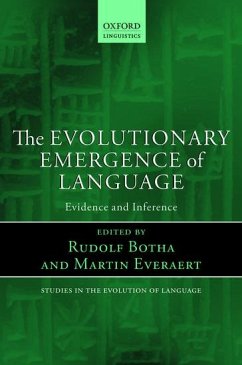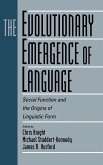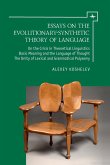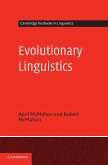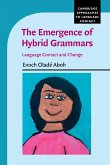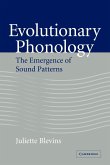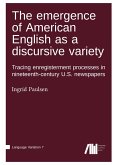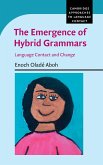Evolutionary Emergence of Language
Evidence and Inference
Herausgeber: Botha, Rudolf; Everaert, Martin
Evolutionary Emergence of Language
Evidence and Inference
Herausgeber: Botha, Rudolf; Everaert, Martin
- Gebundenes Buch
- Merkliste
- Auf die Merkliste
- Bewerten Bewerten
- Teilen
- Produkt teilen
- Produkterinnerung
- Produkterinnerung
Leading primatologists, cognitive scientists, anthropologists, and linguists consider how language evolution can be understood by means of inference from the study of linked or analogous phenomena in language, animal behaviour, genetics, neurology, culture, and biology.
Andere Kunden interessierten sich auch für
![The Evolutionary Emergence of Language The Evolutionary Emergence of Language]() Chris Knight / Michael Studdert-Kennedy / James Hurford (eds.)The Evolutionary Emergence of Language117,99 €
Chris Knight / Michael Studdert-Kennedy / James Hurford (eds.)The Evolutionary Emergence of Language117,99 €![Essays on the Evolutionary-Synthetic Theory of Language Essays on the Evolutionary-Synthetic Theory of Language]() Alexey KoshelevEssays on the Evolutionary-Synthetic Theory of Language33,99 €
Alexey KoshelevEssays on the Evolutionary-Synthetic Theory of Language33,99 €![Evolutionary Linguistics Evolutionary Linguistics]() April McmahonEvolutionary Linguistics107,99 €
April McmahonEvolutionary Linguistics107,99 €![The Emergence of Hybrid Grammars The Emergence of Hybrid Grammars]() Enoch Oladé AbohThe Emergence of Hybrid Grammars47,99 €
Enoch Oladé AbohThe Emergence of Hybrid Grammars47,99 €![Evolutionary Phonology Evolutionary Phonology]() Juliette BlevinsEvolutionary Phonology61,99 €
Juliette BlevinsEvolutionary Phonology61,99 €![The emergence of American English as a discursive variety The emergence of American English as a discursive variety]() Ingrid PaulsenThe emergence of American English as a discursive variety50,00 €
Ingrid PaulsenThe emergence of American English as a discursive variety50,00 €![The Emergence of Hybrid Grammars The Emergence of Hybrid Grammars]() Enoch Oladé AbohThe Emergence of Hybrid Grammars127,99 €
Enoch Oladé AbohThe Emergence of Hybrid Grammars127,99 €-
-
-
Leading primatologists, cognitive scientists, anthropologists, and linguists consider how language evolution can be understood by means of inference from the study of linked or analogous phenomena in language, animal behaviour, genetics, neurology, culture, and biology.
Produktdetails
- Produktdetails
- Verlag: OUP Oxford
- Seitenzahl: 356
- Erscheinungstermin: 25. Juli 2013
- Englisch
- Abmessung: 240mm x 161mm x 25mm
- Gewicht: 764g
- ISBN-13: 9780199654840
- ISBN-10: 0199654840
- Artikelnr.: 37332836
- Herstellerkennzeichnung
- Libri GmbH
- Europaallee 1
- 36244 Bad Hersfeld
- gpsr@libri.de
- Verlag: OUP Oxford
- Seitenzahl: 356
- Erscheinungstermin: 25. Juli 2013
- Englisch
- Abmessung: 240mm x 161mm x 25mm
- Gewicht: 764g
- ISBN-13: 9780199654840
- ISBN-10: 0199654840
- Artikelnr.: 37332836
- Herstellerkennzeichnung
- Libri GmbH
- Europaallee 1
- 36244 Bad Hersfeld
- gpsr@libri.de
Rudolf Botha is Professor of General Linguistics at the University of Stellenbosch, and a Fellow of the Netherlands Institute for Advanced Study. His books include Form and Meaning in Word Formation: A Study of Afrikaans Reduplication (CUP 1988), Unravelling the Evolution of Language (Elsevier 2003) and, co-edited with C. Knight, The Cradle of Language and The Prehistory of Language (both OUP 2009). Martin Everaert is Professor of Linguistics and Director of the Institute of Linguistics at the University of Utrecht. His research interests include syntactic theory and the lexicon-syntax interface and his books The Syntax of Reflexivization, (Dordrecht: Foris 1986) and, as co-editor, The Unaccusativity Puzzle (OUP 2004), The Blackwell Companion to Syntax (2007), and The Theta Sytsem (OUP 2012).
* 1: Rudolf Botha and Martin Everaert: Introduction: evidence and inference in the study of language evolution * 2: Stephen R. Anderson: What is special about the human language faculty and how did it get that way? * 3: Morten H. Christiansen: Language has evolved to depend on multiple-cue integration * 4: Ann Senghas, Asli OzyÃ
rek, and Susan Goldin-Meadow: Homesign as a way-station between co-speech gesture and sign language: the evolution of segmenting and sequencing * 5: Maggie Tallerman: Kin selection, pedagogy and linguistic complexity: whence protolanguage? * 6: Katharine MacDonald and Wil Roebroeks: Neanderthal linguistic abilities: an alternative view * 7: Thomas Wynn, Frederick L. Coolidge, and Karenleigh Overmann: The archaeology of number concept and its implications for the evolution of language * 8: Peter GÃ
rdenfors: The evolution of semantics: sharing conceptual domains * 9: Jacques Vauclair and HÃ(c)lÃ
ne Cochet: Speech-gesture links and the ontogeny and phylogeny of gestural communication * 10: Alban Lemasson, Karim Ouattara, and Klaus ZuberbÃ
hler: Exploring the gaps between primate calls and human language * 11: Kathleen R. Gibson: Talking about apes, birds, bees, and other living creatures: language evolution in light of comparative animal behaviour * 12: Alan Langus, Jana Petri, Marina Nespor, and Constance Scharff: FoxP2 and deep homology in the evolution of birdsong and human language * 13: Karl C. Diller and Rebecca L. Cann: Genetics, evolution, and the innateness of language * References * Indexes
rek, and Susan Goldin-Meadow: Homesign as a way-station between co-speech gesture and sign language: the evolution of segmenting and sequencing * 5: Maggie Tallerman: Kin selection, pedagogy and linguistic complexity: whence protolanguage? * 6: Katharine MacDonald and Wil Roebroeks: Neanderthal linguistic abilities: an alternative view * 7: Thomas Wynn, Frederick L. Coolidge, and Karenleigh Overmann: The archaeology of number concept and its implications for the evolution of language * 8: Peter GÃ
rdenfors: The evolution of semantics: sharing conceptual domains * 9: Jacques Vauclair and HÃ(c)lÃ
ne Cochet: Speech-gesture links and the ontogeny and phylogeny of gestural communication * 10: Alban Lemasson, Karim Ouattara, and Klaus ZuberbÃ
hler: Exploring the gaps between primate calls and human language * 11: Kathleen R. Gibson: Talking about apes, birds, bees, and other living creatures: language evolution in light of comparative animal behaviour * 12: Alan Langus, Jana Petri, Marina Nespor, and Constance Scharff: FoxP2 and deep homology in the evolution of birdsong and human language * 13: Karl C. Diller and Rebecca L. Cann: Genetics, evolution, and the innateness of language * References * Indexes
* 1: Rudolf Botha and Martin Everaert: Introduction: evidence and inference in the study of language evolution * 2: Stephen R. Anderson: What is special about the human language faculty and how did it get that way? * 3: Morten H. Christiansen: Language has evolved to depend on multiple-cue integration * 4: Ann Senghas, Asli OzyÃ
rek, and Susan Goldin-Meadow: Homesign as a way-station between co-speech gesture and sign language: the evolution of segmenting and sequencing * 5: Maggie Tallerman: Kin selection, pedagogy and linguistic complexity: whence protolanguage? * 6: Katharine MacDonald and Wil Roebroeks: Neanderthal linguistic abilities: an alternative view * 7: Thomas Wynn, Frederick L. Coolidge, and Karenleigh Overmann: The archaeology of number concept and its implications for the evolution of language * 8: Peter GÃ
rdenfors: The evolution of semantics: sharing conceptual domains * 9: Jacques Vauclair and HÃ(c)lÃ
ne Cochet: Speech-gesture links and the ontogeny and phylogeny of gestural communication * 10: Alban Lemasson, Karim Ouattara, and Klaus ZuberbÃ
hler: Exploring the gaps between primate calls and human language * 11: Kathleen R. Gibson: Talking about apes, birds, bees, and other living creatures: language evolution in light of comparative animal behaviour * 12: Alan Langus, Jana Petri, Marina Nespor, and Constance Scharff: FoxP2 and deep homology in the evolution of birdsong and human language * 13: Karl C. Diller and Rebecca L. Cann: Genetics, evolution, and the innateness of language * References * Indexes
rek, and Susan Goldin-Meadow: Homesign as a way-station between co-speech gesture and sign language: the evolution of segmenting and sequencing * 5: Maggie Tallerman: Kin selection, pedagogy and linguistic complexity: whence protolanguage? * 6: Katharine MacDonald and Wil Roebroeks: Neanderthal linguistic abilities: an alternative view * 7: Thomas Wynn, Frederick L. Coolidge, and Karenleigh Overmann: The archaeology of number concept and its implications for the evolution of language * 8: Peter GÃ
rdenfors: The evolution of semantics: sharing conceptual domains * 9: Jacques Vauclair and HÃ(c)lÃ
ne Cochet: Speech-gesture links and the ontogeny and phylogeny of gestural communication * 10: Alban Lemasson, Karim Ouattara, and Klaus ZuberbÃ
hler: Exploring the gaps between primate calls and human language * 11: Kathleen R. Gibson: Talking about apes, birds, bees, and other living creatures: language evolution in light of comparative animal behaviour * 12: Alan Langus, Jana Petri, Marina Nespor, and Constance Scharff: FoxP2 and deep homology in the evolution of birdsong and human language * 13: Karl C. Diller and Rebecca L. Cann: Genetics, evolution, and the innateness of language * References * Indexes

